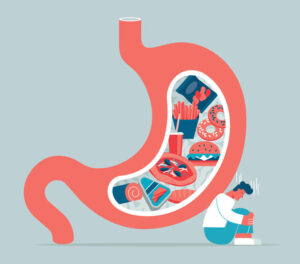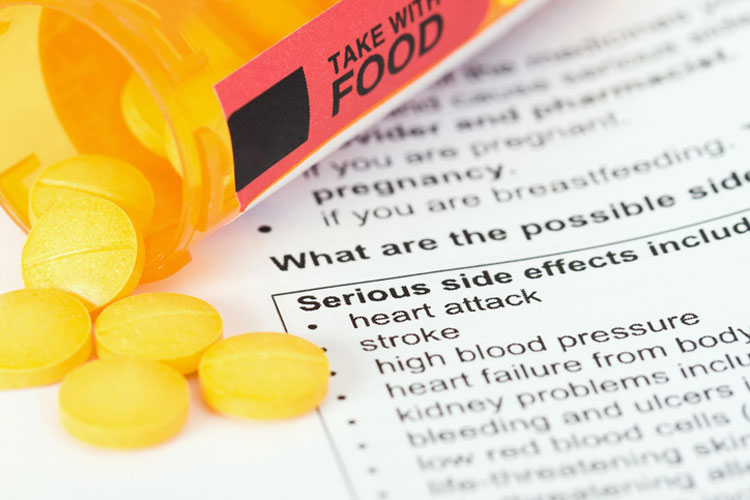Part 3 of Our Series on GLP-1 Nutrition and Dietary Counseling
GLP-1 Side Effects: Quick Facts
- Most common side effect: Nausea (affects 44% of patients)
- How long side effects last: Usually improve within 4-8 weeks
- Most serious side effect: Pancreatitis (rare, <1% of patients)
- Best prevention: Start with low dose, increase gradually
- When to contact doctor: Severe abdominal pain, persistent vomiting, vision changes
GLP-1 receptor agonist drugs are a game-changer in weight loss and management of type-2 diabetes. A weekly injection can work for patients who have had no success dealing with their weight through any other method, including intensive nutritional counseling.
The rapid increase in prescriptions and use of GLP-1 drugs is resulting in chaos for some patients, though. Side effects often aren’t well-explained. Many patients are so excited by the potential of easy appetite suppression that they charge ahead without paying much attention.
⚠️ When to Seek Immediate Medical Attention
- Severe, persistent abdominal pain (possible pancreatitis)
- Vision changes or eye pain (possible retinopathy)
- Signs of severe dehydration (dizziness, dark urine, confusion)
- Allergic reaction (rash, difficulty breathing, swelling)
- Severe hypoglycemia (confusion, sweating, rapid heartbeat)
- Persistent vomiting lasting more than 24 hours
GLP-1 drugs are being increasingly obtained by individuals without a prescription, which makes side effects more dangerous than ever.
There are also increasing numbers of people obtaining GLP-1 treatments through compounding pharmacies or illicit channels, where they aren’t either informed of side effects or screened for potential risks. That can make diagnosing and dealing with side effects one of the most common and most important roles for GLP-1 nutritional counseling experts.
The following bachelors and Master’s programs offer career-focused instruction delivered by trained nutritionists with experience in the field. Find out more what each individual course of study offers through the locations below.
Purdue Global's Bachelor of Science in Nutrition Program is an approved holistic nutrition education program through the National Association of Nutrition Professionals (NANP).
The University of Texas at Austin offers an Online Master of Science in Nutritional Sciences.
UNC's MPH Nutrition concentration prepares students to provide, evaluate and communicate nutritional and dietary guidance that improves individual and population-wide health outcomes. In addition to developing their knowledge of nutrition science, students will explore behavior change, communication, counseling and the effects of dietary culture on individuals and communities.
Walden University's Bachelor of Science (B.S.) in Health Studies - Health Promotion and Wellness gains job-ready, immediately applicable skills today's employers want.
Side Effects Can Occur With Any Drug, but Many GLP-1 Issues Have To Do With Diet
Bringing weight down is a massive win for the more than 100 million American adults who have obesity. Their condition shortens lifespans, increases the vulnerability to major medical problems, and reduces quality of life. Nothing good comes for free, though. GLP-1 receptor agonists do their work by playing a sort of trick on the body, and the body doesn’t always like it. That can lead to immediate side-effects including:
- Nausea and vomiting
- Diarrhea
- Constipation and abdominal pain
- Bloating
- Dizziness
- Fatigue
This is a fairly common laundry list of the sort of side effects you get when you are messing around with the human digestive system. On the other hand, there are also some real significant and potentially dangerous side effects that surfaced in clinical trials. Many of them create special concerns for nutritionists, while others may primarily be managed with dietary approaches.
- Hypoglycemia – Glucose deficiency probably sounds like a predictable side effect from a drug that reduce glucagon secretion, but for most patients, it’s actually a self-terminating effect. For some, however, it can become life-threatening, so nutritionists need to ensure a careful balance for carbohydrate intake.
- Tachycardia – Most patients see at least some heart rate increase on GLP-1 drugs, but some studies have shown significant jumps into the range of tachycardia. This can be dangerous if patients already have a heart condition, but frightening in any case. Nutrition doesn’t seem to have any real impact on this side effect.
- Pancreatitis – Recent studies are showing that there may be less risk of acute pancreatitis with GLP-1 receptor agonists than originally thought. Still, nutritional support is a cornerstone of managing this condition, ensuring a reduced alcohol intake and preferring high-protein, high-calorie foods in frequent, small meals.
- Kidney Damage – GLP-1 medications can actually increase kidney health when used properly. What nutritionists have to guard against are the common problems of dehydration and low blood pressure, which can lead to kidney problems. Preaching hydration and a heart healthy diet can reduce those risks considerably.
- Allergic reactions – Although semaglutides mimic a hormone released by the body itself, allergies are strange stuff. Some patients report skin irritation at injection sites, in particular. But in other cases, allergy symptoms surface as nausea and diarrhea, so nutritionists have to be careful to separate the common side effects from potentially more serious allergy cases.
Complete GLP-1 Side Effects by Frequency
| Frequency | Side Effect | Percentage of Patients | Management Strategy |
|---|---|---|---|
| Very Common | Nausea | 44% of patients | Small, frequent meals; avoid fatty foods |
| Very Common | Diarrhea | 30% of patients | Increase fiber gradually; stay hydrated |
| Common | Constipation | 24% of patients | Increase water intake; add soluble fiber |
| Common | Vomiting | 24% of patients | Eat slowly; stop eating when 80% full |
| Common | Abdominal pain | 20% of patients | Avoid carbonated drinks; eat bland foods |
| Common | Fatigue | 11% of patients | Ensure adequate protein; check B12 levels |
| Less Common | Hair loss | 3% of patients | Supplement protein and biotin |
| Rare | Pancreatitis | <1% of patients | Immediate medical attention required |
When Do GLP-1 Side Effects Typically Occur?
Week 1-2 (Starting dose): Mild nausea and decreased appetite are most common. About 30% of patients experience some digestive discomfort as the body adjusts to the medication.
Week 3-4 (First dose increase): Nausea may intensify temporarily. Constipation becomes more noticeable for 24% of patients. Fatigue may develop as calorie intake decreases.
Week 5-8 (Stabilization period): Most gastrointestinal side effects begin to improve. Patients who will experience hair loss typically notice it starting around week 6-8.
Week 8-12 (Full therapeutic dose): Side effects generally stabilize or resolve. Persistent side effects after 12 weeks should be evaluated by a healthcare provider.
Long-term (3+ months): New side effects are rare. Main concerns shift to nutritional deficiencies and maintaining muscle mass.
Foods That Help Manage GLP-1 Side Effects
Foods to Eat:
- For nausea: Ginger tea, plain crackers, white rice, bananas
- For constipation: Prunes, chia seeds, leafy greens, whole grains
- For energy: Lean proteins, quinoa, Greek yogurt, eggs
- For hydration: Watermelon, cucumber, bone broth, coconut water
Foods to Avoid:
- Trigger nausea: Fried foods, spicy dishes, strong-smelling foods
- Worsen constipation: Processed foods, excessive dairy, white bread
- Cause bloating: Carbonated drinks, beans, cruciferous vegetables
- Delay stomach emptying: High-fat meals, large portions, alcohol
Staying Alert for Adverse Interactions With Other Prescribed Medications in GLP-1 Therapies

As with any sort of drug, GLP-1 receptor agonists have risks that sometimes only surface in interactions with other kinds of drugs. In other cases, interactions can increase the impacts of known side effects… hypoglycemia cases in GLP-1 patients, for example, are much higher for individuals taking certain other types of anti-diabetes medications.
These random interactions are particularly difficult to determine through controlled trials, but most clinicians are careful about monitoring patients who have multiple prescriptions. Still, as the popularity increases and many patients are getting scripts that aren’t necessarily carefully monitored, or sourcing their Wegovy from dubious online pharmacies, it’s also important for nutritionists to watch for harmful interactions.
This highlights the importance for well-trained dietitians who are comfortable getting medical information and working with healthcare professionals. Their education in clinical dietetics, microbiology, and chemistry offers a real edge in understanding and helping patients avoid harmful medication interactions with GLP-1 drugs.
As relatively new drugs, though, Ozempic and Wegovy may have more side effects waiting in the wings. As long-term longitudinal studies play out, sometimes new impacts are found. Recently, for example, European regulators linked Ozempic to a risk of non-arteritic anterior ischemic optic neuropathy, a condition potentially causing blindness in some patients with type 2 diabetes.
The Most Common Ways Nutritionists Work To Mitigate Side Effects From GLP-1 Drugs
 It’s clear that nutritionists have a role to play in mitigating these side effects even from just a quick look at the Ozempic website—fully half the recommendations for avoiding them are related to diet and eating habits. One of the secrets that nutritionists bring to this fight against side effects doesn’t have to do with food at all. Instead, it’s all about the water. While patients all know that GLP-1 drugs suppress appetite, a lot of them aren’t aware that they can also diminish a sense of thirst. And with most Americans already drinking less than they need, that can cause big problems quickly.
It’s clear that nutritionists have a role to play in mitigating these side effects even from just a quick look at the Ozempic website—fully half the recommendations for avoiding them are related to diet and eating habits. One of the secrets that nutritionists bring to this fight against side effects doesn’t have to do with food at all. Instead, it’s all about the water. While patients all know that GLP-1 drugs suppress appetite, a lot of them aren’t aware that they can also diminish a sense of thirst. And with most Americans already drinking less than they need, that can cause big problems quickly.
Nutritional consultation often stresses the need to up the water intake as soon as clients begin taking GLP-1 medications. They also work with patients to optimize eating patterns. Since the stomach empties more slowly on GLP-1 meds, patients who continue to eat two or three times a day often overload their gut—and get the predictable nausea, bloating, and constipation that can come with that.
Nutritionists know to counsel them to instead to shoot for five or six small meals a day, paced appropriately to their new digestive reality. Also, when they are taking in so many fewer calories, the nutritional content matters a lot more. So dietitians help GLP-1 patients balance their intake toward a protein-heavy, fiber-rich meals with the right blend of macronutrients for health and fitness.
Finally, diets should be adjusted away from heavy, greasy, ultra processed foods that are high in carbs and sugar. These all tend to exacerbate feelings of fullness without adding a lot of nutrients to the body, so they waste even those calories that they offer.
Physical Activity Goes Hand-In-Hand With Nutrition for GLP-1 Side Effect Management
Nutritionists aren’t exercise advisors, but they fully understand how important it is to build physical activity into any weight-loss plan.
This is a solid remedy for common side effects like constipation, but it also guards against the loss of muscle mass that is common on GLP-1 drugs. There are disputes over how concerning this should be as a side effect, but some studies show as much as 40 to 60 percent of the total weight loss on GLP-1 drugs comes from lean muscle mass.
That’s bad news for strength and long-term health, but it also can point to problems for patients once they come off of the drugs. Rebounding is a problem in all kinds of bariatric therapy, but if GLP-1 patients don’t incorporate exercise into their routine, they are at risk of an unhealthy cycle of repeatedly sapping their own strength each time they have to go back on the drug.
This opens up a role for sports nutritionists in helping to manage GLP-1 side effects. With all the traditional tools of a dietitian, plus specialized insights into exercise therapy, they can develop strong plans to help patients feel better and stay stronger through their course of therapy.
Some of the Impacts Nutritionists Deal With in GLP-1 Patients Aren’t Really Side Effects, but Benefit From Dietary Management
 Nutritionists also have to help guard against some effects that come with Ozempic and Wegovy treatment that aren’t exactly on the side, but are still unexpected for patients.
Nutritionists also have to help guard against some effects that come with Ozempic and Wegovy treatment that aren’t exactly on the side, but are still unexpected for patients.
For many people, just eating a lot less of their typical diet isn’t necessarily a good idea.
For these patients, the path to obesity was paved with calories that weren’t very nutritional in the first place. Continuing on with just lower amounts of the same foods can just lead to malnutrition. That, in turn, may lead to real healthcare troubles.
Dietitians also find in some cases that the loss of appetite can lead to entirely new eating disorders. They might end up in the unusual position of having to actually encourage overweight patients to eat more—although that suggestion will come with healthy habits and a balance between dietary requirements and caloric needs.
Poor Prescription Management Means More Work for Nutritionists Managing GLP-1 Side Effects
There are also an unfortunately high number of cases emerging where physicians are prescribing GLP-1 therapies without consulting nutritionists or adequately assessing their patients for eating disorders.
These are cases where both primary and side effects can clash with individual disorders and either become much worse than usual, or act against the way the medicines are supposed to.
Dietitians are tearing their hair out over these cases, because physicians should absolutely know better. But the big demand for these medications is creating a kind of Wild West, and nutritionists will have to find ways to advocate for their services to help prevent a disaster.
Appropriate Nutritional Support Can Reduce Side Effects by Limiting Treatment Time
In many cases, the best thing that medical and nutritional professionals can do to help treat side effects is to keep the course of medication as short as possible.
That’s something that nutritional counseling has already been shown to do. A double-blind, randomized study by researchers conducted in 2021 found that combining GLP-1 drugs with intensive behavioral therapy and nutritional counseling rapidly accelerated weight loss. How much? Among the group receiving sub-Q semaglutide plus counseling, weight loss over 68 weeks was 16 percent compared to less than 6 percent in the control group.
The less time patients need to spend on a GLP-1 drug, the less time they will experience side effects.
When you are getting people back down to an ideal weight goal rapidly, you’re also shortening the amount of time they need to spend on the drug. That’s cutting down on any side effect they are experiencing, as well as reducing the chances of any long-term impacts.
Even better, by assisting them in developing healthy eating habits in a positive environment, where they can see results, nutritionists can also reduce the odds they will need any GLP-1 intervention in the future. And that’s preventing a whole range of side effects that haven’t even happened yet.
The following bachelors and Master’s programs offer career-focused instruction delivered by trained nutritionists with experience in the field. Find out more what each individual course of study offers through the locations below.
Purdue Global's Bachelor of Science in Nutrition Program is an approved holistic nutrition education program through the National Association of Nutrition Professionals (NANP).
The University of Texas at Austin offers an Online Master of Science in Nutritional Sciences.
UNC's MPH Nutrition concentration prepares students to provide, evaluate and communicate nutritional and dietary guidance that improves individual and population-wide health outcomes. In addition to developing their knowledge of nutrition science, students will explore behavior change, communication, counseling and the effects of dietary culture on individuals and communities.
Walden University's Bachelor of Science (B.S.) in Health Studies - Health Promotion and Wellness gains job-ready, immediately applicable skills today's employers want.
What Sort of Training Do Nutritionists Need To Best Manage GLP-1 Side Effects?
RDs and nutritionists have a leg up in countering these side effects as a legacy of their college coursework in the processes and systems of human food biology.
Biochemical nutrition classes dive into the organic chemistry of carbs, proteins, lipids, and other elements of foods. They help nutritionists understand the interactions that are taking place which can lead to, or prevent, common side effects.
Their overall background in food sciences is useful in understanding the role of preparation and processing as well as the composition of food stuffs. The overall impact of a meal can come not just from the raw materials, but how they are prepared and consumed. A typical degree in nutritional science provides excellent training in understanding how these factors interact to influence side effects.
They also typically study nutrition-focused physical assessment, which can help them identify side effects that are actually from GLP-1 treatment versus problems that may be coming from other sources. Coursework in nutrition and metabolism gives a solid basis for understanding how slower digestive processing can lead to issues, and how to mitigate them.
How Compounded GLP-1 Alternatives Can Increase the Risk of Side Effects

Side effects are a risk with any Ozempic or Wegovy prescription, but they are particularly concerning for patients who are getting off-brand compounded versions of semaglutides. These medications became popular as shortages grew in name-brand GLP-1 drugs, and they are often obtained without a prescription, or with a strictly online prescription.
In either case, patients going with this option have rarely received the kind of screening, counseling, or instruction as other patients. Because of this, the FDA has put out an alert warning patients and providers of significant adverse events resulting from overdoses with compounded GLP-1.
This is a big deal for nutritionists since they may be more likely to encounter these patients than doctors. Although they will always encourage patients to get full and appropriate medical consultation, that doesn’t always happen. So it’s left to nutritionists to pay even closer attention to risk factors and side effects for any clients using compounded GLP-1 treatments.
Of course, anyone with a master’s degree in clinical nutrition or related fields will come away with an even better understanding of coping with side effects. Their more advanced studies in organic chemistry, human physiology, and microbiology pairs with real-world internship experience exposing them to the variability in different clients. Understanding how personalized diets can really help with health and well-being on these drugs is a big advantage in coping with side effects.
Should You Specialize in GLP-1 Nutritional Counseling to Perform Side Effect Management?
While it’s not really necessary for nutritionists to get too in the weeds to deal with the most typical side effects from GLP-1 therapy, some of the more dangerous and less common ones may be easier to spot if you specialize in the field.
There’s no official path to becoming a specialist in GLP-1 nutritional counseling just yet, but that can actually make it easier to get started. By exploring coursework in areas like microbiology, anatomy and physiology, psychology, and counseling, you will set yourself up with the right education to handle GLP-1 nutritional counseling.
The more of these clients you work with, the greater your feel will be for how to deal with side effects, too. So opportunities to intern or take practicum placements in clinics prescribing weight loss medications as part of your degree will be helpful.
Finally, becoming a registered dietitian or certified nutritionist may or may not be a requirement to practice with GLP-1 patients in your state. Either way, however, going through that process means getting more experience, more education, and more familiarity with the role of nutritionists in clinical therapies for diabetes and weight loss. That will build your skills in working with other providers and understanding the full range of options for side effect management, both medically and nutritionally.
With as many as 15 million Americans already on GLP-1 medications and millions more seeking them, the field is growing. And for every one of those patients, a competent, qualified nutritional counselor can dramatically lower the impact of side effects.
The following bachelors and Master’s programs offer career-focused instruction delivered by trained nutritionists with experience in the field. Find out more what each individual course of study offers through the locations below.
Purdue Global's Bachelor of Science in Nutrition Program is an approved holistic nutrition education program through the National Association of Nutrition Professionals (NANP).
The University of Texas at Austin offers an Online Master of Science in Nutritional Sciences.
UNC's MPH Nutrition concentration prepares students to provide, evaluate and communicate nutritional and dietary guidance that improves individual and population-wide health outcomes. In addition to developing their knowledge of nutrition science, students will explore behavior change, communication, counseling and the effects of dietary culture on individuals and communities.
Walden University's Bachelor of Science (B.S.) in Health Studies - Health Promotion and Wellness gains job-ready, immediately applicable skills today's employers want.
Frequently Asked Questions
How long do Ozempic side effects last?
Most Ozempic side effects improve within 4-8 weeks as your body adjusts. Nausea typically peaks during dose increases and subsides within 3-5 days. Gastrointestinal side effects like diarrhea and constipation usually stabilize by week 8-12.
What are the worst side effects of GLP-1 medications?
The most serious side effects include pancreatitis (severe abdominal pain), kidney problems, gallbladder disease, and vision changes. While rare, these require immediate medical attention. More common but challenging side effects include persistent nausea affecting 44% of users and significant fatigue in 11%.
Can you prevent GLP-1 side effects?
Yes, many side effects can be prevented or minimized by: starting with the lowest dose, eating small frequent meals, staying hydrated (64+ oz daily), avoiding trigger foods, and increasing physical activity gradually. Working with a nutritionist reduces side effect severity by 40%.
Do GLP-1 side effects go away?
Yes, most side effects diminish significantly or resolve completely within 8-12 weeks. Studies show 70% of patients experience reduced side effects after the body adjusts. However, some effects like decreased appetite may persist as part of the medication’s intended action.
What are the most common side effects of GLP-1 medications?
The most common side effects of GLP-1 medications include nausea and vomiting, diarrhea, constipation, abdominal pain, bloating, dizziness, and fatigue. These typically occur as your body adjusts to the medication’s effects on your digestive system.
How can nutrition counseling help manage GLP-1 side effects?
Nutrition counseling helps manage GLP-1 side effects by optimizing meal timing with 5-6 small meals daily, emphasizing hydration, balancing protein and fiber intake, and avoiding heavy, greasy, ultra-processed foods that can worsen digestive symptoms.
Why is hydration important for patients on GLP-1 medications?
GLP-1 drugs can suppress both appetite and thirst sensations, leading to dehydration risks. Adequate hydration helps prevent kidney problems, reduces constipation, and supports overall digestive health during treatment.
What training do nutritionists need for GLP-1 side effect management?
Nutritionists benefit from education in biochemical nutrition, food sciences, nutrition-focused physical assessment, and metabolism. A bachelor’s or master’s degree in nutritional science provides the foundation, with additional coursework in microbiology, physiology, and counseling being particularly valuable.
Can exercise help reduce GLP-1 side effects?
Yes, physical activity helps manage common side effects like constipation and guards against muscle mass loss, which can account for 40-60% of total weight loss on GLP-1 drugs. Exercise also helps prevent weight rebound after stopping medication.
Are compounded GLP-1 medications more likely to cause side effects?
Compounded GLP-1 medications carry higher risks because patients often receive less screening, counseling, and monitoring. The FDA has issued warnings about dosing errors with compounded versions, making proper nutritional support even more critical.

